

At home with Barbie – these are the pieces of furniture and design classics from the film
The film airs on 20 July in Swiss German cinemas and will feature a new Dreamhouse with one or two design icons in it.
As a kid, I dreamed of owning the furniture from my portable nineties Barbie dollhouse. Even today, I get the urge again to have the design pieces from the Barbie movie house in my apartment. This time I’m going to make my dreams come true.
Director Greta Gerwig and set designers Sarah Greenwood and Katie Spencer bring not only toys, but also real furniture to the big screen. What those exactly are, they haven’t revealed (yet). Luckily, there’s an official set tour for the Architectural Digest Magazine. I took a close look so I can show you which brands the furniture from the movie comes from – in case, like me, you want to turn your dreams into reality.
An open kitchen with a retro look
The first thing I notice when I look at the Dreamhouse is that Barbie’s decor thrives on a nostalgic style as well as some modernist furniture with Scandinavian influences. One example can be found in the kitchen. Instead of a high-tech fully automatic machine, the Radiofonografo greets me. The music device is a record player and AM/FM radio in one. It was developed in 1965 by the designers Achille and Pier Giacomo Castiglioni, costs about 14,000 euros in our world and fits a lot better visually than a standard Bluetooth speaker from Sonos.
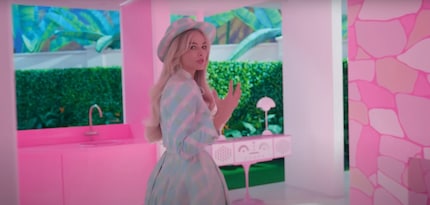
Source: Architectural Digest
The Radiofonografo is enhanced by the Flowerpot table lamp from the furniture brand And Tradition, designed in the sixties by the Danish architect and designer Verner Panton. Barbie has two of these lamps, one in white and one in pink – perhaps because its shape is inspired by a flower pot. Thanks to their shape, the lamps fill in for indoor plants that are missing throughout the villa.
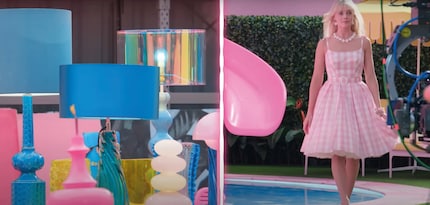
Source: Architectural Digest
Even the toaster is pink. I notice the 50s Style Retro Toaster from Smeg on the kitchen top. The colour, the typical 1950s design of the northern Italian company and its heating function are a perfect match: the toaster warms slices of bread and has a bagel button so Barbie can brown just one side of her bagel.
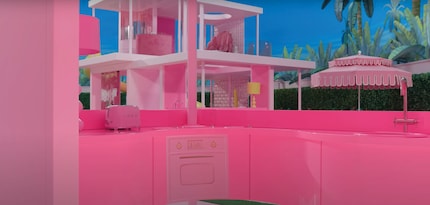
Source: Architectural Digest

Scandi design and Czech glass art in the dining area
At the bar, I notice the first stylistic inconsistency. Here, the barely ten-year-old Form bar stool by Normann Copenhagen shines. The Danish man behind the design is Simon Legald. He designed the bar stool with the aim of creating a chair as if it was a single mould; the seat and the frame form a single unit. To support the seamless look, the bar stool is available in all black, white, red or grey. For us mere mortals anyway. Barbie was mysteriously able to get them in pink.
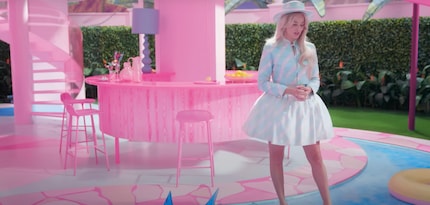
Source: Architectural Digest
In addition to Italian and Scandinavian design, I find some Czech influences in the Dreamhouse: the two glass jugs on the bar counter are possibly the Polka Dot series from the Květná glassworks. They date back to 1794. However, although they have a distinctive structure, there’s other hand blown jugs in the Czech Republic in the same style, such as those made by the glass manufacturer Klimchi. It’s unclear where Barbie’s model in baby pink comes from, but one thing is for certain: the house owner likes handmade items.
The dining area and its accessories aren’t obviously located either. The vases resemble the Zach and Ronda designs from Danish brand Hübsch and would fit in with the rest of the Scandinavian flair.
The table and chairs are reminiscent of the Tulip dining table and Tulip chair by Eero Saarinen. Finnish architect and furniture designer Eero Saarinen designed the Tulip collection for German manufacturer Knoll in the sixties because he didn’t like the many legs under tables and chairs. Never in pink, though. At most, there was a version in which the seat upholstery was covered with pink fabric. So Barbie owns either a plagiarism or one of the numerous reinterpretations, like the Kare Design table. In any case, tulip-inspired furniture is another style element that brings florals into the home.
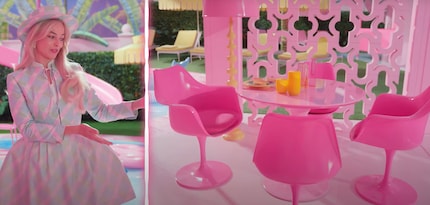
Source: Architectural Digest
The living area with a mid-century look
The sofa appears to be a custom-made version of Pierre Paulin's 1968 «Amphis»-Canapés. While it exists in our world, it is mostly found in galleries. The design of the sofa is inspired by Scandinavian furniture, the Japanese style and the work of the Eames couple. The soft silhouette often appears in furniture design in the second third of the 20th century and is now celebrating a comeback. Swiss brand Kare Design, for example, has incorporated the arch shape into a recamier. But much more exciting is that the sofa consists of two parts. Barbie can either have it in an s shape or an arc.

Source: Architectural Digest
Glitter and glamour in the bedroom
So far, the lower level of the house has been a pink explosion, but not exactly glamorous. Barbie’s bedroom is different. Here, lamps with iridescent surfaces meet a bed with a velvet shell headboard and sequin bedspread. Unlike the rest of us, Barbie sleeps on round decorative velvet cushions from the Beliani brand. Just a wild guess.
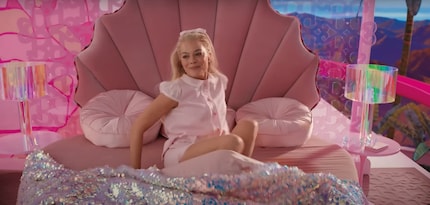
Source: Architectural Digest
From no-name to design icon
In the old dream mansion Barbie’s Fun House 2021 there was a yellow hanging chair that was swinging next to the slide. It was a reference to the Bubble Chair by Eero Aarnio from 1968.
Barbie now has the original chair made of acrylic, solid stainless steel and natural leather, which in the real world costs about 4,300 euros. Therefore it could be the most expensive piece of furniture in her dream villa. According to Eero, the Bubble Chair is supposed to hang from the ceiling, because «there’s no way to create a pretty clear base.» Therefore, like the bubbles of Barbie’s bathtub, it floats above the ground.
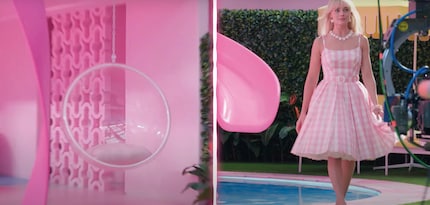
Source: Architectural Digest
Although the cocoon-like hanging chair should shield the outside world, here it does the opposite because it’s transparent. Perfectly fitting the film. «There’s nowhere to hide in Barbie land – her house has no walls,» says Sarah Greenwood in an interview with Wallpaper Magazine. «And there’s nowhere to hide for the design.»
Did you notice any other design pieces in the Barbie film? Then let me know in the comments.
Header image: Architectural Digest
Like a cheerleader, I love celebrating good design and bringing you closer to everything furniture- and interior design- related. I regularly curate simple yet sophisticated interior ideas, report on trends and interview creative minds about their work.
Interesting facts about products, behind-the-scenes looks at manufacturers and deep-dives on interesting people.
Show all
